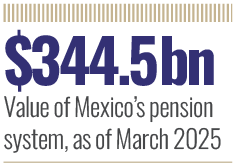
& nbsp
Author: David Razú Aznar, Managing Director, after XXI Banort
The volatility of the financial markets has ceased to be an exclusive concern to sophisticated investors. In the context of today of global interdependence, any fluctuation in stock markets is directly affected over the lives of millions. One of the most sensitive and less visible links of this volatility chain is its impact on pension funds. Indeed, the fate of future retirees is increasingly linked to the global market compass.
Falls, recovery and uncertainty
On April 2, a surprise announcement of a large set of reciprocal rates affecting almost all the main business partners was unveiled in the United States. The market reaction was immediate. The S&P 500 fell 4.8%, the NASDAQ plunged six percent and the main European and Asian markets followed the same downward trajectory. The actions of technology giants such as Apple, Nvidia and Tesla have recorded losses between five percent and nine percent. These decreases reflected the concerns of investors concerning the potential of a broad commercial conflict.
The fate of future retirees is increasingly linked to the global market compass
A week later, on April 9, President Trump introduced a tactical adjustment: a 90 -day break on these commercial measures and a reduction to 10% of the prices initially announced, triggering a large rebound. However, the truce was only partial: China was excluded and subject to a rate of 125%, highlighting a selective negotiation strategy which introduced both flexibility and uncertainty.
Above the same time, the criticism of the president of the president of the Federal Reserve Jerome Powell intensified, in particular on the pace of interest rate adjustments. These public declarations had notable effects on the markets, sometimes contributing to volatility. The traditionally independent role of the Fed – long considered as a foundation of American economic stability – has faced an in -depth examination.
However, the most consecutive episode to date has occurred on May 12, when the United States and China have negotiated a 90-day commercial truce. The agreement has considerably reduced the bilateral prices and triggered another gathering in shares. In a single session, the NASDAQ jumped 4.3% and the S&P 500 won 3.2%. The dollar has strengthened, the appreciated yuan and the world markets have rejoiced.
Is this the end of volatility? Barely. Rather than isolated events, these developments highlight the broader uncertainty introduced by a new, more assertive American approach to commercial policy – marked by daring negotiation strategies aimed at obtaining more favorable results for the American economy.
Investments with vulnerabilities
In this context, it is important to recall that the pension funds go to a large part of their assets to the shares, even when the regulations limit these investments. In Mexico, the administrators of the pension funds (AFORES) hold 19.2% of their assets invested in shares, including 70% in foreign markets. For funds targeting young workers, this share increases to 23.7%.
This means that although pensions are intrinsically long -term instruments, short -term market shocks can have considerable impacts. In April, for example, AFO recorded an effective monthly return of –0.6%, equivalent to an –6.9% annualized. However, the perspectives are not entirely negative. The yield of the start of the year (YTD) in April, even before the rally launched by the US Chinese agreement, was held to be a positive efficiency of 3.7%, or almost 12% annualized. In fact, since the creation of the Mexican system before in 1997, the real annual yield has on average 4.8% (or 10.5% in nominal terms), despite various financial crises during the decades: the global financial crisis of 1997-1998, the CRIPRIME of 1995-2002, the crisis of Sovere Cold from 2010 to 2020, the 2020-13 years Pandemic, and now, the turbulence caused by President Trump’s trade policies.
In addition, even in the short term, not all funds know the same level of exposure. The target date fund, managed by Afores and designed for workers born after 2000, posted a monthly yield of –0.5%in April, but an effective ytd return of 4.2%, equivalent to an annualized return of more than 13%. On the other hand, the target date of funds targeting people aged 60 and over was barely assigned, recording a monthly yield of –0.05% and a 5.1% ytd yield, equivalent to more than 16% annualized. These differences reflect the generational structure of the Mexican system: those which are closer to retirement are better protected from volatility by a higher allowance to safer assets, such as State obligations.
The good news is that the change in target dates of Mexico has proven to be effective. The bad news is that, despite recent market recoveries, the international context remains complex and uncertain, which can hinder long -term strategies as trade tensions become structural.
World economic model markets
What is at stake is not simply the health of quarterly profits or performance of actions. It is the very model of economic globalization that has supported global growth for decades. The protectionist policies adopted by the United States, while being nuanced in its implementation, dispute the basic principles of free trade.
Pensions are based on sustained economic growth and long -term real positive yields
Even after the truce with China, the American average rates have remained at levels not seen since the 1930s. According to estimates from the Yale budget laboratory, the average American price is now 16.4% after recent adjustments. Trade partners, including Europe, responded by hardening their own commercial barriers. The result: an international climate of mounting tension and reduced cooperation.
For the moment, the International Monetary Fund (IMF) has revised its world growth forecasts in 2025 to only 1.7%. It is estimated that this year, global GDP growth will exceed trade growth, which implies that trade as part of world production will decrease. In this environment, global economic growth is in danger. GDP is expected to increase by 2.8% in 2025, compared to 3.3% in 2024. The United States has already reported a real GDP contraction of 0.3% in the first quarter. Trade, historically a key engine of expansion, is now compromised by the closing of economic borders.
The dilemma of monetary policy
In addition, the federal reserve faced President Trump’s pressure at a drop in interest rates. The objective is clear: to support economic growth and strengthen stock market performance. However, Jerome Powell resisted these calls, stressing the importance of carefully monitoring inflation, especially in the face of cost increases caused by prices.
This dilemma between Orthodox monetary policy and short -term political considerations is becoming more and more frequent in advanced democracies. What is at stake is not only the level of interest rate, but the institutional autonomy of central banks. This rope shooting also affects markets, contributing to increased uncertainty.
Pensions and productivity
In the middle of this scenario, it is worth returning to the basics: pensions are based on sustained economic growth and real positive yields in the long term. The realization of this requires more than short -term stock rallies: it requires investments in human, physical and technological capital.
Productivity – and not protectionism – is the key to securing worthy pensions. If the world falls into a decreased cooperation cycle, reduction in trade and increased uncertainty, the effects will be more sustainable than any temporary recovery from Nasdaq. In the end, international trade, by expanding markets, promoting specialization and increasing competition, promoting economic growth by creating jobs, also reducing production costs, increasing innovation and technology transfer, and therefore improving life levels.

There is no doubt that stock market performance depends on the growth of global consumption and investment in global economic development. And the last decades have shown that the widespread overvoltage of consumption in all regions was hand to the expansion of international trade.
Mexico’s retirement system has demonstrated resilience, reaching a 32% increase in assets over two years, reaching $ 344.5 billion in March 2025. This is a good sign, but complacency is not an option. World economic policy shapes the structural conditions that will determine the viability of future pensions.
A long -term perspective
Recent market volatility is not accidental. It reflects a deeper transition in the rules of world economic order. In this context, sailing funds and pensions in the world are confronted with the challenge of navigating uncertainty with a long -term perspective, recognizing that institutional stability, international trade and productive investment remain the cornerstone of any viable retirement system, because they are the foundation of sustained economic growth.
It is the responsibility of long -term actors, such as retirement systems, to remain anchored in the long term, because in the end, it is not only the markets – these are people who, after a work life, expect to retire with dignity.
